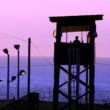Redha Al-Najar was at home with his wife and child in May 2002 when armed, masked men kicked in his front door and trained their guns on him while his family looked on. He was taken from his home and loaded into an awaiting vehicle. Then he was gone.
Eighteen months later, Houcine Al-Najar, who lives in Switzerland, received an envelope from the International Committee of the Red Cross, which included a letter from his brother. Redha Al-Najar was at the Bagram Theater Internment Facility, on the U.S. Bagram Airbase, near Kabul, Afghanistan. He was in the custody of the U.S. Army. Along the way he had spent some time in at least one “black site,” probably operated by the CIA or contractors working for the CIA, where evidence suggests he was tortured.
The Bush-Cheney administration executed thousands of these renditions and detentions as part of its response to the terrorist attacks of September 11, 2001. Indefinite detention with no legal recourse continues under the Obama administration as the policy of the United States, which holds 645 prisoners at Bagram.
A legal challenge making its way through the federal courts might change that. Al-Najar, a Tunisian living in Karachi, Pakistan, when he was abducted, is one of three plaintiffs represented by a team of lawyers working with the International Justice Network. Fadi Al-Maqaleh, a Yemeni abducted more than six years ago, is the second plaintiff. Another Yemeni, Amin Al-Bakri, is the third. It is unclear where Al-Maqaleh was detained, though he claims it was outside of Afghanistan. Al-Bakri was kidnapped while on a business trip in Thailand. Before he turned up at Bagram, he spent some time as a “ghost prisoner” at unknown locations, where his attorneys say he likely was tortured.
Attorneys representing the three men are asking the courts for relief for harm inflicted during the Bush administration. But the case styled Fadi Al-Maqaleh et al. v. Robert Gates et al. bears directly on the current administration. Although Barack Obama says he has banned torture as U.S. policy, he has retained the right to use rendition, the practice of abducting terrorist suspects in one country and transferring them to another for detention and interrogation.
These are difficult cases. None of the American attorneys have been allowed to speak to their clients. Held largely incommunicado, the detainees depend on family members to represent their interests. The government has resources the plaintiffs’ attorneys lack. And the government owns the narrative: the details of detention and the alleged crimes the detainees have committed, all of which can be classified as secret.
Yet in April of last year, Federal District Judge John D. Bates ruled that the government can no longer detain the three men without providing them access to courts in the United States. In a 42-page opinion that dismantled the Bush administration’s arguments, Bates ruled that the detainees have the right to habeas corpus—the touchstone of American criminal jurisprudence, established by the Magna Carta.
DETENTION SHELL GAME—Bates cited the last of four Supreme court decisions that extended habeas rights to prisoners at Guantánamo. “Aside from where they are held, Bagram detainees are no different from Guantánamo detainees,” Bates wrote. He said the Defense Department uses Bagram as it once used Guantánamo. By moving prisoners detained outside of Afghanistan to Bagram, beyond the reach of U.S. law, the executive branch can again “switch off the Constitution.” Bates dismissed the government’s argument that providing legal rights to Bagram detainees is impossible because the prison is located in a theater of war. The detainees are in a theater of war only because the government of the United States put them there, after abducting them in countries that were not at war. The government appealed Bates’s decision.
NEW CLIENT, NEW ARGUMENT—In 2003, as a Georgetown University law professor working pro bono, Neal Katyal represented Salim Ahmed Hamdan in a lawsuit filed against Secretary of Defense Donald Rumsfeld. Hamdan, who had been Osama bin Laden’s driver, was held at Guantánamo. In Hamdan v. Rumsfeld, Katyal successfully argued that the military tribunals the Bush administration put in place were inadequate.
“We have a government of divided powers, and the president can’t just make the rules up as he goes along and act as the prosecutor and judge and jury in these things,” Katyal told the News Hour‘s Margaret Warner.
It would appear that as Barack Obama’s deputy solicitor general, Katyal is perfectly positioned to craft a solution that would provide some justice for the detainees at Bagram, in particular for the 36 prisoners who were not captured in the Afghan war zone but were taken there from other countries.
Arguing the government’s appeal of the Al-Maqaleh decision before the Court of Appeals for the District of Columbia Circuit on January 7, Katyal reiterated most of the arguments that Judge Bates had dismissed—beginning with the impossibility of providing justice in a war zone and the harm that would be done to U.S.-Afghan relations if habeas were extended to prisoners in Afghanistan.
The convoluted politics of the moment were too evident. If Bates—a conservative appointed by George W. Bush who also sits on the secret Foreign Intelligence Surveillance Court—had been merciless in his criticism of the process provided to prisoners at Bagram, Katyal now was relentless in its defense. Yet the review process the government has devised for Bagram detainees doesn’t meet even the low standards of Guantánamo “justice” that Katyal challenged when he represented Salim Hamdan.
In her argument for the plaintiffs before the D.C. appeals court, Tina Foster, from the International Justice Network, described a closed detainee review process that provides no lawyers, admits hearsay and evidence obtained by torture, and relies on classified evidence the detainees are not allowed to see.
The hearing before Chief Judge David Sentelle, and Judges David Tatel and Harry Edwards, suggests how difficult it is for the judicial system to address extrajudicial policies, such as abduction and detention outside the United States. Judges Edwards and Tatel appeared sympathetic to Foster, but also seemed to fear that by ruling for the three detainees they would extend habeas corpus to all detainees on any U.S. military installation anywhere in the world.
The two judges agonized their way toward some solution. Both Edwards and Tatel repeatedly asked Foster for guidance in how the court could write an opinion that would be limited in its scope, yet provide her clients access to courts in the United States. At one point Edwards said: “You’re not answering…. Tell us what you would write.”
NO EXIT—There are no easy answers. The World War II-vintage Supreme Court case, Johnson v. Eisentrager, held that U.S. courts had never extended habeas to detainees held overseas. But as Foster pointed out, a military tribunal had convicted the Eisentrager detainees of war crimes. Her clients were convicted of nothing. And as Judge Bates wrote, the “war on terror” is a war with no spatial or temporal boundaries—a war whose prisoners can be incarcerated forever.
Katyal argued that individuals swept up in that war have only the legal rights (and basic human rights) that the Obama administration, or its successor, allows them.
The post-9/11 world is a dangerous place, and there is little doubt that many dangerous men are locked up at Bagram. But based on what is known about Guantánamo, Bagram is also the long-term home for many innocent individuals.
How long is too long when a prisoner is provided no legal process? At least one federal judge has now ruled that six years is enough for the three prisoners represented by the International Justice Network.
The case was complicated by the last-minute filing of a sealed ex parte motion by the government, along with sealed evidence. And by news reports that the U.S. is beginning the process of handing over the Bagram prison to the Afghans.
Judge Sentelle assured an angry Foster that the secret filing would not inform the court’s decision.
In a telephone interview after the hearing, Foster addressed the news of the transfer of the prison. “If it happened,” she said, “and our clients were transferred to Afghan custody, it would be relevant.” Foster said that U.S. authorities have already “expressed their intent to turn over Afghan detainees —and not foreign nationals—to the Afghan government.
“And the agreement the U.S. has with the Afghan government still allows the U.S. to stay at Bagram in perpetuity,” Foster said.
The appeals court should rule in several months. Add another year for appeal to the Supreme Court. Absent a change in policy by the Obama administration, Redha Al-Najar will do at least seven years in Bagram.
Post Script: Give the Obama administration credit for some small progress at Bagram. On January 15, the Defense Department released the names of the prisoners held there, in response to an American Civil Liberties Union Freedom of Information Act lawsuit filed in September 2009.






0 Comments